The Imaging Resource
Quick Review
Panasonic Lumix DMC-LX1 Digital Camera
| Camera QuickLook | ||
|
Reviewed by |
|
|
|
Review Date |
|
|
|
User Level |
|
|
|
Product Uses |
|
|
|
Digicam Design |
|
|
|
Picture Quality |
Excellent, 8.4-megapixel CCD | |
|
Print Sizes |
Good 11 x 17 inches, or 8 x 10 with heavy cropping; plus 16:9 panoramas! |
|
|
Availability |
|
|
| Suggested Retail
Price (At introduction) |
|
|
Introduction
|
|||||||||||
Panasonic says the Lumix brand name was coined from the words luminance and mix, representing the optical technologies contributed by Leica and the digital imaging technologies Panasonic added to the mix. In fact, each Lumix sports a Leica DC lens and all the current lineup are optically stabilized with Panasonic's Mega Optical Image Stabilization. The very Leica-like Panasonic Lumix LX1 stands out from the crowd. It has switches in unusual places, a fine lens, a great feel, and a wide aspect 8 megapixel sensor.
Among the many unusual aspects of the Panasonic Lumix LX1, one stands out, and that's the camera's 16:9 ratio sensor. Unlike most digital cameras with a 4:3 or 3:2 ratio sensor, the LX1's 16:9 sensor is only at its maximum 8.4 megapixel resolution at that ratio; from there, the sides get cropped off, and the actual total number of pixels falls from 8 to 7.1 megapixels at 3:2 and 6.0 megapixels at 4:3. Leaving it locked to 4:3 for familiarity's sake would be very much like getting a wide screen TV and watching only old VHS video tapes: you end up wasting much of the screen area left and right. Even the squarish 4:3 ratio viewfinder LCD gives you the impression that the camera is cutting off the top and bottom of the image (as most cameras do) but ironically with the Panasonic LX1, when the display isn't being used at its fullest, the sensor actually is being used fully, and only then is the lens showing its full 28mm equivalent. Aye carumba! The emails we'll get. Read on for all the details.
| f2.8 at 1/8 sec. Optically stabilized |
While the Panasonic Lumix DMC-LX1 is an undeniably competent--even exciting--point-and-shoot digicam, we quickly came to appreciate it as something more like a rangefinder. It's as playful and friendly as any point-and-shoot, but it can also be as serious as any high-end digicam.
That covers quite a bit of territory and it took us a while to believe it, but the more we used the LX1, the more respect we had for it.
High Points. We were delighted to see, first of all, those magic letters, "PASM" on the Panasonic LX1's mode dial. (PASM are three separate exposure modes that most photographers know as "Program, Aperture priority, Shutter priority, and Manual.") There are a lot of point-and-shoots that pretend some kind of manual control, but the Panasonic LX1 delivers the real thing. The simple joystick makes it easy to select either the aperture or shutter speed with a left or right nudge and make an adjustment with an up or down nudge, checking the live histogram for feedback. You can't even do that with a dSLR, but the better digicams actually give you a live preview of what the image will look like if captured at a given exposure setting.
Having Aperture Priority and Shutter Priority modes is just part of the PASM package. But team up Shutter Priority with the Panasonic LX1's Mega Optical Image Stabilization and you can shoot available light photography without worries at insanely slow shutter speeds. Progammed Auto is as simple to use as the Auto mode found on any digicam, but it comes without the restrictions and provides a little control, too.
| Aspect Ratio Switch 16:9 for your HDTV |
One reason to buy a digicam rather than a dSLR is Movie mode. And the LX1's Movie mode is a standout, offering broadcast quality HDTV with a 16:9 aspect ratio at 30 frames per second. It can do VGA at 10 fps, if you like, but it will fill your plasma TV, too.
| Focusing Modes On the lens, of course |
| Retro Power Switch Stabilizer button in front |
That failure to follow the trend is something you get used to quickly with the Panasonic LX1. The power switch is a funky little thing on the top panel, not elegantly meshed with the panel or the mode dial or anything else. Menu selection deviates, too, using the right arrow to make a selection rather than the Menu button.
| The Joystick Below AF AE/Lock |
LCD. It's a large 2.5-inch LCD with a Power Assist function to brighten it up in daylight. Just hold down the Display button a second or two and the display will momentarily brighten. This is handy, because there's no rangefinder-like optical viewfinder on the Panasonic LX1.
| Joystick Focusing Note yellow scale |
| 4:3, 3:2 and 16:9 |
Performance. That big LCD draws some power and the LX1 does get a bit warm delivering it, but battery life was sufficient for all of our events. The combination SD slot and battery compartment is pretty conventional these days. The included 32-MB SD card is a little more generous than most, but still insufficient. You really need something more like a 256MB to 512MB to last as long as the battery.
| Fault Line 3840x2160 pixels |
In Short. No matter what your level of interest or expertise, the Panasonic LX1 will reward your effort. I was particularly enchanted by its refusal to short change the knowledgeable photographer, but I was equally charmed by how easy it was to use.
| Hairpin Turn Put this on your plasma TV |
Panasonic has delivered on its Lumix promise, melding the best of the old with the most exciting of the new in the LX1. This little camera just clicks.
Basic Features
- 8.61-megapixel 16:9 CCD (8.4-Mp effective)
- 2.5-inch color TFT LCD monitor
- 4x, 6.3-25.2mm lens, equivalent to a 28-112mm lens on a 35mm camera
- Maximum 4x digital zoom
- Automatic and manual exposure control
- Shutter speeds from 1/2,000 to 60 seconds
- Maximum aperture of f/2.8 to f/4.9, depending on lens zoom position
- Built-in flash with five modes
- SD memory card slot for storage
- Power supplied by a 3.7v Li-ion battery pack or optional AC adapter
- Software CD included for both Windows and Mac platforms
Special Features
- Selectable 4:3, 3:2, and 16:9 aspect ratios
- Raw, TIFF, and JPEG file formats
- Optical image stabilization
- Joystick
- 16:9 Movie mode with sound at up to 30 frames/second
- Unlimited Continuous Shooting mode
- Two- or 10-second Self-Timer for delayed shutter release
- Audio Dub option for recording captions
- White balance (color) adjustment with five modes, including a Custom setting
- White Balance Adjust function allows fine-tuning of preset or custom white balance
- Color Effects including Cool, Warm, Black and White, and Sepia
- Adjustable image sharpening and saturation
- Adjustable ISO setting
- DPOF (Digital Print Order Format) and PictBridge compatibility
- USB cable for connection to a computer (driver software included)
- A/V cable for connection to a television set
Recommendation
Panasonic's Lumix series of digital cameras have proven to be very popular option with consumers, thanks to a combination of competitive prices, good resolution and unusual feature-set, including optical image stabilization (a feature other manufacturers reserve only for their long-zoom digicams). The Panasonic Lumix DMC-LX1 adds a few more goodies to the mix with a 16:9 sensor perfect for HDTV playback and a joystick to navigate the menu system displayed on the generous 2.5-inch LCD. In addition to the simplicity of its Auto mode, it also includes Program Auto, Aperture Priority, Shutter Priority and Manual modes, making it a more serious piece of equipment than many of its competitors. The Panasonic LX1 makes a good "all around" camera and a capable second camera for enthusiasts who'd like to experiment with different aspect ratios.
With the minimalist Leica rangefinder styling that's been a hallmark of the company's Lumix lineup, the Panasonic LX1 looks clean and functional, with a 4x Lumix DC Vario-Elmart optical zoom lens that dominates the front panel. Measuring 3-11/16 x 1-15/16 x 15/16 inches (94.1 x 50 x 24.2 millimeters) excluding the lens projection, the Panasonic LX1 weighs approximately 7.3 ounces (207 grams) with the battery and storage card installed. While it won't fit easily into your shirt pocket, the accompanying wrist strap offers a sense of security when carrying the camera.
The front of the Panasonic LX1 is dominated by the telescoping 4x Lumix DC Vario-Elmart zoom lens, and to its right (as seen from the camera's rear) the minimal two-tone handgrip. At the very top of the camera's front panel, just to the right of the lens, is the red LED light emitter that serves as the self-timer countdown indicator and autofocus assist lamp. At the very top left-hand corner of the front panel is the pop-up flash strobe lid.
The right side of the Panasonic LX1 (as viewed from the back) features only the hinged, plastic door that covers the connector compartment, and an eyelet for the wrist strap. This compartment houses the Audio/Video port which doubles as the Digital Out port, and also contains the DC In connector terminal.
The opposite side of the Panasonic LX1 is featureless. But from this side you can see the Focus slide switch on the lens barrel, which offers three settings: Autofocus, Autofocus Macro, and Manual Focus.
The Panasonic Lumix LX1's top panel features a Mode dial near the center, along with the Shutter button, Zoom lever, Optical Image Stabilizer button, and Power switch, all to the right. The Zoom lever surrounds the Shutter button, which has a good feel for the difference between a half and full press. A set of three small holes just to the left of the Mode dial is the camera's microphone. And at the far left side is a slide switch that pops the flash up. The flash itself pops up from the front left side of the top panel. Also from the top, you can see the Aspect Ratio switch on the Panasonic LX1's lens barrel, offering three settings: 4:3, 3:2, and 16:9.
The majority of the Panasonic LX1's exposure controls are located on the camera's rear panel, along with the 2.5" LCD monitor. Running down the right side of the LCD monitor are the Autofocus/Auto Exposure Lock button, the Joystick, a small LED Status Indicator, and a set of four navigation buttons, each of which also serve as EV, Flash mode, Review, and Self Timer buttons. In the center is the Menu button. In a row below the navigation configuration are the Display/Power LCD button and the Burst/Delete button. A textured thumb grip at the very top right corner of the camera's rear reinforces the modest handgrip on the camera's right side.
The Panasonic LX1's bottom panel is reasonably flat, with a sliding door to access the combined battery and SD/MMC memory card compartment at the right of the camera, and a threaded plastic tripod mount near the left rear corner. The tripod mount is positioned off-center from the lens, and is too close to the left side of the camera to provide a stable platform. The tripod mount is far enough from the battery compartment to allow for quick battery changes when the camera is mounted on a tripod.
The Panasonic Lumix DMC-LX1's user interface is straightforward enough that it shouldn't require more than a relatively short learning curve if you read through the included manual. Buttons are sparse enough to encourage you to hit the Menu button when you're looking for something and that usually retrieves it. More helpful is the joystick, which is a blessing in Manual mode.
Record Mode Display: In any record mode, the LCD display shows either the image area with information, image with information and live histogram, alignment grid, and image with no information modes. Pressing the Display button cycles through the available displays. When the information display is active, it reports battery life, resolution and image quality settings, the number of available images, the specific Record mode, orientation, and a handful of exposure settings (including the predicted aperture and shutter speed).
Playback Mode Display: Playback mode also offers three display modes, including the image only, the image with information, and the image with expanded information and a histogram. You can also display nine, 16, or 25 thumbnail images at a time with the Panasonic LX1's index display mode, or zoom in by up to 16x on captured images to check fine details, focus, or framing.
External Controls
Shutter Button: Located on the right side of the Panasonic LX1's top panel and surrounded by the Zoom lever, the Shutter button sets focus and exposure when halfway pressed, and when fully depressed, it trips the shutter release. In Self-Timer mode, fully depressing the Shutter button triggers a two- or 10-second countdown before the shutter is released.
Zoom Lever (see image above): Surrounding the Shutter button, this lever controls the optical and digital zoom in any Record mode.
In Review mode, pushing the lever toward the "W" end activates a nine, 16, or 25 image index display mode. Pushing the lever to the "T" end digitally enlarges a captured image as much as 16x. When playback zoom is active, pushing the lever back toward the "W" zooms back out.
Mode Dial: To the left of and slightly behind the Shutter button, this notched dial on the camera's top panel is used to select the Panasonic LX1's shooting modes as follows:
- Movie Mode: Records short movie clips with sound at either 4:3 or 16:9 aspect ratios. At 4:3, options include 10 or 30 fps at VGA or SVGA quality. At 16:9, options include 10 or 30 fps. Recording time is limited only by the capacity of the SD card in the camera (and of course the remaining battery life). A handful of exposure controls are available in this mode, including exposure compensation, white balance, frame rate, AF mode, digital zoom, optical stabilization, and color effect. However, once recording starts, the aperture, optical and digital zoom, and focus are locked for the duration of recording.
- Manual Mode: This mode lets you control both the aperture setting and the shutter speed using the joystick to both select and set the control. When you half press the shutter button, the aperture and shutter speed values turn red if the exposure isn't what the camera thinks it should be. Auto ISO is not available in this mode.
- Shutter Priority Mode: In this mode, you control the shutter speed and the camera compensates with the aperture setting. When you half press the shutter button, the aperture and shutter speed values turn red if the exposure isn't adequate.
- Aperture Priority Mode: In this mode, you control the aperture and the camera compensates with the shutter speed. When you half press the shutter button, the aperture and shutter speed values turn red if the exposure isn't adequate. Auto ISO is not available in this mode.
- Program Mode: The camera automatically sets the shutter speed and the aperture as in Simple mode, but you can shift either value by toggling up and down with the joystick. In addition, you retain control over other exposure and image options. Auto ISO is not available in this mode.
- Auto Mode: In this mode, most user options are removed, but without the dumbed-down terminology that we see on most Panasonic digital cameras. Still, it's even more limited, allowing control only over Picture size, Quality, and Digital Zoom. All continuous mode options are available. Flash options are reduced to just Off, On, and Auto with Red-Eye Reduction. The self-timer function offers both two and 10-second options, and the Image Stabilizer is permanently set to Mode 1.
- Playback Mode: This mode allows you to scroll through captured images and movies, write-protect images, view a nine-image index display, zoom into a captured image, delete unwanted images, rotate images, set up images for printing on DPOF compatible devices, as well as play movies.
- Scene Modes (two options): Both the SCN1 and SCN2 positions on the Mode dial set the Panasonic LX1 for image capture, and access all of the nine preset scene modes. The reason for the duplication on the Mode dial is that through the Setup menu, you can opt for the last used scene mode to be automatically selected when entering the Scene mode -- allowing you to leave the SCN1 and SCN2 options set to different Scene modes you frequently use. By default, SCN1 is Portrait and SCN2 is Sports. Alternatively, you can set the camera to automatically present you with a menu listing all available modes when either scene mode is entered. Scene mode choices are Portrait, Sports, Food, Scenery, Night Portrait, Night Scenery, Baby, Soft Skin, Candle Light, Party, Fireworks, Snow, Starry Sky, and Self-Portrait.
Optical Image Stabilizer Button: Directly to the right of the Panasonic LX1's Shutter button/Zoom lever combo on the top panel, this button accesses the camera's image Stabilizer function, which attempts to reduce image blurring caused by camera shake. The Stabilizer can be disabled altogether, or can be set to Modes 1 or 2. In Mode 1 the Stabilizer functions continuously. Mode 2 operates the Stabilizer only during the actual image capture, which conserves power and potentially provides a slightly better chance of capturing a blur-free image (when in Mode 1, the Stabilizer may already have used much of its available range to correct shake that occurred just before the shutter was released, and hence may not have as much latitude to correct the shake during the actual exposure).
Power Switch: Directly behind the Optical Image Stabilizer button, this sliding switch turns the camera on or off. Powering the Panasonic LX1 on with the Mode dial set to a record mode triggers the lens to extend. Likewise, turning the camera off causes the lens to retract.
Display Button: On the rear of the Panasonic LX1, off the lower right corner of LCD display, this button controls the image and information displays in Record and Playback modes. In Record mode, pressing the button cycles between the four display modes, which include the image with information, image with information and live histogram, alignment grid, and image with no information modes.
In Playback mode, pressing the button cycles between the image with information, expanded information and histogram, and no information displays.
Pressing and holding the button in either mode brightens the Panasonic LX1's screen until it is pressed and held again.
Four-Way Arrow Pad: Located above right of the Panasonic LX1's Display button, this group of four buttons accesses a variety of camera settings. Menu options may be navigated and camera settings adjusted using the buttons as arrow keys. In addition, in most Record modes the up arrow accesses the Exposure Compensation. The right arrow cycles through the available flash modes, while the left arrow cycles through the Self-Timer modes. The down arrow activates a quick review of the most recently captured image. In Auto mode, the Up arrow instead activates a backlight compensation feature.
In Playback mode, the right and left arrow keys navigate through captured images and movie files. The down arrow key starts or stops movie playback. While a movie is playing, the left and right arrow keys cue through the movie, while the up arrow key pauses the movie. When an image has been digitally enlarged, the four arrow keys pan around within the image.
Menu Button (see image above): The Menu button is in the middle of the Four-Way Arrow Pad. It calls up the Settings menus on the LCD display in all camera modes and includes a tab for the Recording mode or Display mode options. A further press of the Menu button cancels the menu display.
Burst Mode/Delete Button: Directly below and to the right of the Panasonic LX1's Four-Way Arrow Pad. In most Record modes, this button accesses the three Burst modes (High, Low, or No Limit), or returns to the single-shot mode. In Playback and Review modes this button pulls up the Delete menu.
Camera Modes and Menus
Record Mode: In Record mode, the Panasonic LX1 can capture still images or movies, with a range of options available through the Record menu. The Exposure Mode dial sets the exposure control mode. The LCD menu -- accessed by pressing the Menu button in any Record mode -- provides the following exposure options (some options are not available in all modes):
- Record Menu: Available in all Record modes, but depending on camera setup, it may take a second press of the Menu button to access the menu from the Scene modes (the first displays the Scene menu). The three-page Record menu offers the following selections:
White Balance: Sets the white balance to Auto, Daylight, Cloudy, Halogen, White Set 1, White Set 2, and White Set modes. (White Set isn't a separate white balance mode, it's just the option for manually setting the white point that's selected by the Manual option.) The setting can be fine-tuned using the White Balance Fine Adjustment.
- Sensitivity: Adjusts the camera's sensitivity setting. Choices are Auto, 80, 100, 200, or 400 ISO equivalents.
- Picture Size/Mode: In still Record modes, options for the 4:3 aspect ratio are 6M, 4M, 3M, 2M, and 1M; in 3:2, they are 7M, 4.5M, and 2.5M; and in 16:9, they are 8M, 5.5M, and 2M. In Movie mode, 4:3 options are 10 or 30 fps in either VGA or QVGA size; 16:9 options are 10 or 30 fps.
- Quality: Determines the compression and file format used to record the image. Options include RAW (uncompressed), TIFF (uncompressed), Fine (low compression to maintain image quality), and Standard (high compression to optimize the number of pictures you can store on the card).
- Audio Recording: When enabled, causes the camera to record five seconds of audio with each still photo. (Audio recording isn't available when shooting auto bracket, burst mode or when quality is set to TIFF or RAW.)
Metering Mode: Selects between the default Multiple (which reads the whole screen), Center-weighted (which gives priority to readings from the center of the screen), and Spot (which bases exposure on the reading of the spot target in the center of the screen).
- AF Mode: Sets the Autofocus mode to Nine-Area Focusing, Three-Area Focusing (High Speed), One-Area Focusing (High Speed), One-Area Focusing, or Spot Focusing.
- Continuous AF: When enabled, the camera continually focuses on the scene, helping you to compose the image. If the AF mode is set to One-Area focusing or Spot focusing, half-pressing the shutter button will more quickly set focus.
- AF Assist Lamp: When enabled, the AF assist lamp will turn on under low light conditions to help find focus.
- AF/AE Lock: Sets the AF/AE Lock button to either AF, AE or AF/AE.
Digital Zoom: Enables or disables the digital zoom option.
- Color Effect: Selects a color effect, with options of Cool, Warm, Black and White, or Sepia.
- Picture Adjust: Allows Contrast, Sharpenss, Saturation, and Noise Reduction adjustments of either High, Standard or Low.
- Flip Animation: Creates 5 or 10 fps motion picture files of 320x240 pixels up to 20 seconds long without sound.
- Scene Menu: If designated through the Setup menu, this set of five menus automatically appears whenever the Panasonic LX1 is switched to the SCN1 or SCN2 scene modes. If turned off, pressing the Menu button when in either scene mode calls up this page. For each Scene mode option, you can press the left arrow button to receive a brief description of the mode.
Portrait: Utilizes a larger aperture to decrease the depth of field, and emphasizes flesh tones, resulting in a sharply focused subject in front of a slightly blurred background.
- Sports: Employs a faster shutter speed to "freeze" fast-moving action.
- Food: Enhances certain colors to make food look more appealing.
Scenery: This mode fixes focus at infinity, and is best for capturing wide vistas and landscapes.
- Night Portrait: As with the mode above, the camera uses a slower shutter speed for better color in night shots. However, the flash is set to Slow-Sync with Red-Eye Reduction mode.
- Night Scenery: In this mode, the camera slows the shutter speed to as long as eight seconds, capturing more ambient light and preserving color in darker exposures. (The flash is disabled.)
Baby: Options include With Age, Without Age, and Birthday Set.
- Soft Skin: Suitable for outdoor daytime shootings, the ISO is set to 80.
- Candle Light: Allows yellow cast from candlelit scenes to stay yellow to keep the mood, rather than making the light white.
Party: Best for taking pictures under dim indoor lighting with a flash, you can select between Forced Red-Eye Reduction and Slow-Sync Red-Eye Reduction modes. Biases white balance for indoor lighting.
- Fireworks: Here, the camera uses a slower shutter speed and enhances color slightly to capture the full pattern and color of fireworks.
- Snow: This mode adjusts the white balance and exposure to counter the bright snowy areas of the scene, preventing the camera being fooled into underexposing the shot.
- *
Starry Sky: Options include 15, 30, or 60 second exposures.
- Self Portrait: Enables the self timer so you can take a picture of yourself.
- Play Menu: This three-page menu is only available in the Review mode. It lets you erase, protect, and rotate captured images or movies; or set up images for printing on a DPOF compatible device. The Play menu offers the following selections:
Slide Show: Automatically plays all images or only DPOF selected files in a slide show format. You can designate the display interval for images from one to five seconds, and audio can be enabled or disabled.
- Favorite: When enabled, adds photos to a Favorites list, from which you can run a slideshow including only the Favorites. This does not protect them from deletion.
- Rotate Display: Selects whether images that were tagged as rotated by the camera's orientation sensor, or using the next menu option, should be shown rotated on the LCD display.
- Rotate: Rotates captured images 90 degrees clockwise or counterclockwise.
- DPOF Print: Marks individual or multiple images for printing on a DPOF compatible printer, or cancels marking of images.
Protect: Write protects the currently displayed image, protecting it from accidental deletion, except by card formatting. There's also an option for protecting multiple images at once, or to cancels protection of images.
- Audio Dub.: Lets record a brief audio clip to attach to the currently reviewed image.
- Resize: Lets you resize an image to a smaller resolution and save a separate copy.
- Trimming: A cropping function, this option lets you "trim" an image and save it as a separate file. To trim the image, you use the Playback zoom and pan functions to select the area of the image that you want to retain on the display, and then press the shutter button to save the cropped image.
- Aspect Conversion: Converts the current image to either a 3:2 or 4:3 apect ratio.
Clean Up: Rather like "defragment" on a regular hard drive the Clean Up command can be invoked when file transfer becomes slow or movies don't record well. It's probably better to format more often.
- Format: Formats the SD/MMC card or internal memory, erasing all files (including those that were protected using the Protect menu option).
- Setup Menu: The four-page Setup menu provides universal camera control options that remain the same in both Shooting and Review modes. This menu is accessed by depressing the Panasonic LX1's Menu button once and scrolling to the right with the Multicontroller. Following are the available settings:
Monitor: Adjusts the brightness level of the LCD monitor in seven steps.
- Auto Review: Disables the automatic image review, or sets the review time to one or three seconds. A Zoom option displays the captured image for one second, then zooms it 4x for one second. The Zoom option does not zoom images shot in burst mode, with auto-bracketing, or with audio clips recorded.
- Power Save: Lets you enable or disable the camera's auto power off feature, and change the time before the LCD display "sleeps" to 1, 2, 5, or 10 minutes.
- MF Assist: Sets the Manual Focus Assist feature to either MF1, MF2 or Off. When MF1 is enabled, the center of the screen shows a magnified view of the scene to make it easier to judge focus. When MF2 is set, the whole screen is used for the magnified view. This is a very helpful device for manually focusing.
- Beep: Turns the camera's beep sound on or off, with low and high volume settings.
Shutter: Turns the shutter sound on or off, with low and high volume settings.
- Volume: Sets the speaker volume to one of seven levels.
- Clock Set: Sets the camera's internal clock and calendar.
- No. Reset: Resets file numbering with each new SD/MMC card (Yes setting), or continues file numbering from card to card (No setting). (Continuous file numbering is very handy to avoid accidentally overwriting images you've previously copied to your computer's hard drive.)
- Reset: Resets all record-menu settings to their factory defaults.
- *
USB Mode: Sets the USB mode to PC or PictBridge (PTP).
- Highlight: Indicates blown highlights by flashing them in black and white during auto review or review.
- Video Out: Sets the video output timing to NTSC or PAL. (NTSC for the US and Japan, PAL for most of Europe.)
- TV Aspect: Sets the Aspect Ratio for television playback.
- MF m/ft: Selects meters of feet for distance displays.
Scene Menu: Options are Off or Auto. If Off, the camera automatically reverts the previously used Scene selection when the Mode dial is turned to SCN1 or SCN2. If set to Auto, the Scene menu automatically appears when the mode dial is rotated to one of the SCN positions.
- Language: Changes the menu language to one of seven languages. (English, German, French, Spanish, Italian, Chinese Traditional, or Japanese.)
In the Box
Packaged with the Lumix DMC-LX1 are the following items:
- 32-MB SD memory card
- Li-ion battery pack
- Li-ion battery carrying case
- Li-ion battery charger
- Wrist strap
- Lens cap
- Audio/Video cable
- USB cable
- Software CD-ROM
- Operating manuals and registration card
- Large capacity SD/MMC memory card. (These days, 128 - 256 MB is a good tradeoff between cost and capacity.)
- AC adapter kit
- Small camera case
Recommended Software: Rescue your Photos!
Just as important as an extra memory card is a tool to rescue your images when one of your cards fails at some point in the future. We get a lot of email from readers who've lost photos due to a corrupted memory card. Memory card corruption can happen with any card type and any camera manufacturer, nobody's immune. A lot of "lost" images can be recovered with an inexpensive, easy to use piece of software though. Given the amount of email I've gotten on the topic, I now include this paragraph in all my digital camera reviews. The program you need is called PhotoRescue, by DataRescue SA. Read our review of it if you'd like, but download the program now, so you'll have it. It doesn't cost a penny until you need it, and even then it's only $29, with a money back guarantee. So download PhotoRescue for Windows or PhotoRescue for Mac while you're thinking of it. (While you're at it, download the PDF manual and quickstart guide as well.) Stash the file in a safe place and it'll be there when you need it. Trust me, needing this is not a matter of if, but when... PhotoRescue is about the best and easiest tool for recovering digital photos I've seen. (Disclosure: IR gets a small commission from sales of the product, but I'd highly recommend the program even if we didn't.) OK, now back to our regularly scheduled review...
See camera specifications here.
We ran the Panasonic Lumix DMC-LX1 through our usual battery of tests, and have summarized our findings here. To see the full set of our test images, with explanations of what to look for in them, see the Panasonic Lumix DMC-LX1 Sample Pictures page. For a complete listing of all our test and "gallery" shots, go to the Thumbnails page.
A collection of more random, pictorial images can be found in the Panasonic Lumix DMC-LX1 Photo Gallery.
Not sure which camera to buy? Let your eyes be the ultimate judge! Visit our Comparometer(tm) to compare images from the Lumix DMC-LX1 with those from other cameras you may be considering. The proof is in the pictures, so let your own eyes decide which you like best!
Lens
Zoom
A good 4x optical zoom range, with good performance.
|
28mm (16:9) |
112mm (16:9) |
4x Digital Zoom (16:9) |
The Lumix DMC-LX1 zooms over the equivalent of a 28-112mm range with its Leica lens, with good results across the range. Though some coma distortion is visible at wide angle, results are good overall, with sharp details. The 4x digital zoom takes it out to 16x total, with some loss of quality. Though results are a bit fuzzy with digital zoom enabled, there's still a fair bit of fine detail present.
Macro
A small macro area with good detail and high resolution. The flash had trouble up close.
|
Standard Macro |
Macro with Flash |
The Panasonic LX1's macro setting performs well, capturing a small minimum area of just 2.30 x 1.72 inches (58 x 44 millimeters). Detail and resolution are both great, with only moderate softening in the corners from the lens. (Most cameras have some softening in the corners in macro mode, the LX1 shows a good bit less than most.) The flash had trouble throttling down for the macro area, and overexposed the top left portion of the frame. There's also a strong shadow in the lower right from the lens, so you'll probably want to use external lighting for your closest macro shooting.
Distortion
Some barrel distortion, low pincushion.
This is the tendency for the lens to bend straight lines outward (like a barrel--usually at wide angle) or inward (like a pincushion--usually at telephoto). The Lumix DMC-LX1's 0.6% barrel distortion at wide angle is actually lower average among the cameras I've tested, though the effect is still noticeable. At the telephoto end, the Panasonic LX1's 0.02% pincushion is very low indeed.
| Barrel distortion at 28mm is 0.6% |
| Pincushion at 112mm is 0.02% |
Chromatic aberration
Very low, minimal effect on images at edges.
|
Wide: low, lower right @ 200% |
Tele: low, top right @ 200% |
Chromatic aberration is quite low at wide angle, showing only 1-2 pixels of rather dull coloration on either side of the target lines, and is also low at telephoto. (This distortion is visible as a very slight colored fringe around the objects at the edges of the field of view on the resolution target.)
Corner Sharpness
Strongest softening in the corners at wide angle, with slight softening at telephoto. Better than average overall though.
| Wide: mildly soft in the lower left corner |
Wide: very sharp at center |
| Tele: slightly softer lower right | Tele: not quite as sharp at center |
The Panasonic LX1 produced soft corners in a few shots, with the most noticeable blurring in the top right corner of the frame at wide angle. At telephoto, the corners were slightly soft as well. In all cases though, the softness didn't extend very far into the frame, and the lens overall appeared to be of superior quality.
Sensor
Exposure and White Balance
Indoors, incandescent lighting
Good results with Auto and Manual white balance settings, though Incandescent produced a warm image. Good exposure.
|
Auto White Balance +1.0 EV |
Incandescent WB +1.0 EV |
|
Manual White Balance +1.0 EV |
The Panasonic LX1's Auto and Manual white balance options both responded pretty well to the incandescent lighting here, though the Auto setting was just slightly too red. - Some users may prefer this though, as it conveys a bit more of the warmth of the original lighting, without overdoing it too much. The Incandescent option resulted in a strong warm cast, suggesting that it's actually set to the 3200K color temperature of studio incandescent lighting, rather than the ~2800K of typical household bulbs. Exposure accuracy was about average, as the DMC-LX1 required a +1.0 EV exposure compensation boost for a bright exposure, very typical for this shot. Overall color is good, though the blue flowers in the bouquet appear very dark and purplish. (A very common outcome for this shot.) Our test lighting for this shot is a mixture of 60 and 100 watt household incandescent bulb, a pretty yellow light source, but a very common one in typical home settings here in the US.
Outdoors, daylight
Bright color, a little oversaturated in blues and bright reds, but appealing overall. About average exposure accuracy. High contrast under harsh lighting, but better than average highlight detail.
|
Auto White Balance, +1.0 EV |
Auto White Balance, Auto Exposure |
Outdoor shots showed nearly accurate exposure, though with blown out highlights and dark shadows from the high contrast. The camera typically required some positive exposure compensation under harsh lighting, though results were about average.
See full set of test images with explanations
See thumbnails of all test and gallery images
Resolution
High resolution, 1,200~1,300 lines of strong detail.
Our laboratory resolution chart revealed sharp, distinct line patterns down to about 1,300 lines per picture height horizontally from the Panasonic LX1, and about 1,200 lines vertically. Extinction occurred at around 1,800 lines. (The camera also produced slight color artifacts at lower line frequencies though, visible in the full-sized res target shots.) Use these numbers to compare with other cameras of similar resolution, or use them to see just what higher resolution can mean in terms of potential detail. Beware that while you might be able to make out what looks like distinct lines at numbers higher than those we've mentioned here, the camera is just doing its best to continue interpreting the lines. If you zoom in and follow them from the wider portions, you'll see the lines converge and reappear several times, so the lines you see at 1,600 and higher are really only artifacts generated by the Panasonic LX1's imaging system.
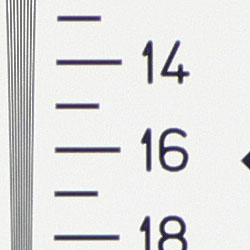 |
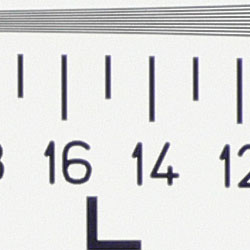 |
|
Strong detail to 1,300 lines horizontal |
Strong detail to 1,200 lines vertical |
See full set of test images with explanations
See thumbnails of all test and gallery images
Sharpness & Detail
Sharp images, with excellent preservation of fine detail. Relatively minor blurring of detail from noise suppression.
The Lumix LX1's images are pretty sharp, with virtually no artifacts from over-eager sharpening or edge enhancement on the camera's part. (Edge enhancement creates the illusion of sharpness by enhancing colors and tones right at the edge of a rapid transition in color or tone. Too much can coarsen or obscure fine details though.)
Noise-suppression systems in digital cameras tend to flatten-out detail in areas of subtle contrast. The effects can often be seen in shots of human hair, where the individual strands are lost and an almost "watercolor" look appears. The crop at far right shows this slightly in the darkest areas of Marti's hair, but the effect is less pronounced than with many cameras we test. (There is more chroma noise present than average in this crop though.)
ISO & Noise Performance
Slightly high noise even at the normal sensitivity settings, very high and bright noise that blurs detail at the higher settings.
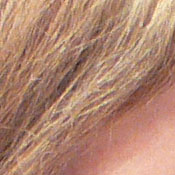 |
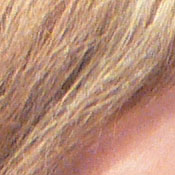 |
|
ISO 80 |
ISO 100 |
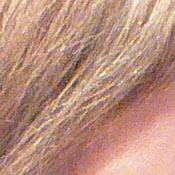 |
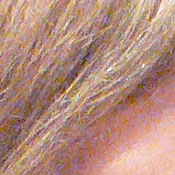 |
|
ISO 200 |
ISO 400 |
The Panasonic LX1's lower ISO settings produced very noticeable noise, with bright pixels and slight blurring. As the ISO setting increases, so does the noise level and the amount of blurring that results, with images at ISO 400 being much softer, with much more chroma (color) noise. We're the first to caution that the noise you see on-screen may not be nearly as evident in prints, but that's unfortunately not the case with the LX1. As noted in the Output Quality section below, ISO 400 shots from the camera are really only usable at up to a 5x7 inch print size. Larger than that and the noise really becomes distracting.
Extremes: Sunlit and low light tests
High resolution with very good detail, though slightly noisy. Better than average handling of tough highlights. Excellent low-light performance, capable of capturing bright images under average city street lighting and much darker conditions.
|
+0.3 EV |
+0.7 EV |
+1.0 EV |
Sunlight:
Because digital cameras are more like slide film than negative film (in that they tend to have a more limited tonal range), we test them in the harshest situations to see how they handle scenes with bright highlights and dark shadows, as well as what kind of sensitivity they have in low light. The shot above is designed to mimic the very harsh, contrasty effect of direct noonday sunlight, a very tough challenge for most digital cameras. (You can read details of this test here.)
The deliberately harsh lighting in the test gave the Panasonic LX1 a bit of a hard time, but it did a bit better than most cameras with it. Though contrast is a little high (even using the camera's low contrast setting) and shadow detail a bit limited, the camera holds onto highlight detail pretty well. Noise is a bit high throughout the frame, and very strong in the deep shadows. At +0.7 EV, midtones are a little dark but the highlights are in check. Most amateurs would probably prefer the shot at +1.0 EV, as the midtones are in a better range, even though more highlight detail is lost. (In "real life" though, be sure to use fill flash in situations like the one shown above; it's better to shoot in the shade when possible.)
Low light:
The Panasonic LX1 handled our low-light challenge very well, capturing very bright images at the lowest light levels we test at, at all four sensitivity settings. The camera's Auto white balance system also handled the test well, capturing good overall color. The autofocus system likewise did much better than average, able to focus on the subject down to the 1/8 foot-candle light level without assistance, and all the way to the darkest light level with its AF-assist light enabled.
NOTE: This low light test is conducted with a stationary subject, and the camera mounted on a sturdy tripod. Most digital cameras will fail miserably when faced with a moving subject in dim lighting. (For example, a child's ballet recital or a holiday pageant in a gymnasium.) For such applications, you may have better luck with a digital SLR camera, but even there, you'll likely need to set the focus manually. For information and reviews on digital SLRs, refer to our SLR review index page.
Color
Saturation & Hue Accuracy
Strong oversaturation in reds and blues, though fairly accurate color otherwise.
The other important part of color rendition is hue accuracy. Hue is "what color" the color is. The DMC-LX1 did push some blues toward a more magenta hue in many cases, and shifted the cyans of sky colors more towards blues than we're accustomed to seeing, but the overall color was still believable, and should be very appealing to most consumers.
(See our s for more shots taken with the camera.)
Viewfinder
Coverage
Excellent accuracy from the LCD monitor, but we miss having an optical viewfinder.
|
28mm eq., LCD monitor |
112mm eq., LCD monitor |
The Panasonic LX1's LCD monitor showed close to about 100 percent frame accuracy at both wide angle (101%) and telephoto (99%). Excellent job!
Flash
Coverage and Range
Disappointing flash range, but surprisingly accurage exposures with the Slow-Sync setting. Slight bluish cast in highlight areas, but overall color pretty good.
| 28mm equivalent | 112mm equivalent |
| Normal Flash +1.3 EV | Slow-Sync Flash Default Exposure |
Flash coverage was a little uneven at wide angle, and quite dim at telephoto (thanks in part to the slightly longer than normal 4x optical zoom lens). In the Indoor test, the Panasonic LX1's flash underexposed our subject at its default setting, requiring a +1.3 EV exposure compensation adjustment to get bright results, slightly more than average. Though the exposure was good, the image shows a pronounced orange cast from the background incandescent lighting. The camera's Slow-Sync flash mode produced a good shot at the default exposure, though with a stronger orange cast.
| 8 ft | 9 ft | 10 ft | 11 ft | 12 ft | 13 ft | 14 ft |
1/30 sec f4.5 ISO 100 |
1/30 sec f4.9 ISO 100 |
1/30 sec f4.9 ISO 100 |
1/30 sec f4.9 ISO 100 |
1/30 sec f4.9 ISO 100 |
1/30 sec f4.9 ISO 100 |
1/30 sec f4.9 ISO 100 |
Even at eight feet, our closest test range, the flash did not quite illuminate the DaveBox target adequately. Flash intensity decreased from there, barely illuminating the target at all at 14 feet.
Output Quality
Print Quality
Excellent print quality, bright color, very usable 13x19 inch prints. Some image noise even at ISO 80 though, and ISO 400 images are only acceptable at 5x7 inches.
Testing hundreds of digital cameras, we've found that you can only tell just so much about a camera's image quality by viewing its images on-screen. Ultimately, there's no substitute for printing a lot of images and examining them closely. For this reason, we now routinely print sample images from the cameras we test on our Canon i9900 studio printer, and on the Canon iP5200 here in the office. (See the Canon i9900 review for details on that model.)
The Panasonic Lumix DMC-LX1 was a bit of a mixed bag in the output quality department. On the one hand, it delivered loads of fine detail, its excellent lens and conservative in-camera sharpening algorithms doing a great job of delivering crisp-looking images without coarsening fine detail or leaving behind other distracting artifacts. The downside is that at least some of this commendable sharpness comes at the expense of image noise: Even minimum-ISO shots in full sunlight show at least some evidence of chroma (color) noise, which increases steadily as you increment the ISO light sensitivity setting. At ISO 400, noise is very evident in 8x10 inch prints, to the extent that we feel most users would find it objectionable. ISO 400 shots printed at 5x7 inches still showed some noise but would probably be marginally acceptable to most users, while prints at 4x6 looked just fine. ISO 200 images still showed some noise at 8x10, but we think it's at a level that most users would accept for prints to be displayed on a wall or table. Overall, image noise is probably the LX1's Achilles' heel, the weakest area of an otherwise excellent camera.
Color-wise, prints from the Panasonic LX1 were bright and appealing, verging on too bright for strong blues and reds. Sky colors were notably intense, not a problem in many shots, but something to think about in the fall and winter, when sky colors get deeper anyway. We did notice a slight tendency to shift some blues towards purples, a characteristic that could occasionally be annoying, but that seemed to affect a relatively narrow range of color. As noted earlier, Caucasian skin tones were rendered slightly pink, but within a range we feel most consumers would find acceptable. Random photos (as opposed to our deliberately-difficult test shots) captured with the LX1 printed out looking bright and beautiful. All in all, color and print quality that most users should find very appealing.
One note about printing the Panasonic LX1's images though: The camera's highest resolution mode is the one with a 16:9 ("HDTV") aspect ratio. This is wider and shorter than most print formats, so even 4x6 inch prints will either lose the edges of the image, or show a white border top and bottom. For 4x6s, you'll want to select the 3:2 aspect ratio, while the 4:3 setting will work best for most larger print sizes and for display on typical computer screens.
Timing and Performance
Panasonic Lumix DMC-LX1 Timing
Good to very good speed for a consumer camera.
| Startup/Shutdown: | |
| Power On to first shot | 3.5 seconds |
| Shutter response (Lag Time): | |
|
Full Autofocus Wide |
0.48 second |
|
Full Autofocus Tele |
0.46 second |
|
Prefocused |
0.019 second |
| Cycle time (shot to shot) | |
| Normal large/fine JPEG | 1.38 seconds |
| Flash recycling | 5 seconds |
| Continuous mode (High Speed) | 0.47 second 2.15 frames/second (5 large/fine frames) |
| Download speed | |
| Windows Computer, USB 2.0 | 731 KBytes/sec |
The Lumix DMC-LX1's performance ranges from quite fast to about average, with a net result of "pretty good" overall, depending on the task. At 3.5 seconds from power-on to the first shot captured, start-up is a little on the slow side, but shutter response is quite good at both wide angle and telephoto. If you prefocus the camera by half-pressing and holding down the shutter button before the final exposure, it's blazingly fast, with a shutter delay of only 0.019 second, among the fastest on the market. Shot to shot cycle times are well on the faster side of average, at about 1.38 seconds per frame for large/fine JPEGs, and there's no limit (other than card capacity) to the number of shots it can capture this quickly. Continuous-mode speed is good in the High Speed setting, at a bit over two frames/second, for up to five shots in succession. The flash takes about five seconds to recharge after a full-power shot, about average for this class of camera. Connected to a computer, download speeds are quick (if not dramatically so) as well. Overall, the Panasonic LX1 is a very responsive camera, fast enough for a wide range of situations, including action shots.
Battery and Storage Capacity
Battery
Very good battery life.
The Panasonic DMC-LX1 uses a custom rechargeable LiIon battery for power. Because it doesn't have a standard external power connector, we weren't able to conduct our usual power consumption tests on it. Panasonic's own numbers for the DMC-LX1 (based on the CIPA standard test procedure) indicate that you should be able to get about 240 shots on a freshly-charged battery, half of those shots using the flash. This compares very well with other cameras the Panasonic LX1 competes with, but if you plan extended outings (which might involve a lot of viewing of images on the LCD screen), you may want to consider purchasing a spare battery.
Storage
The Panasonic LX1 comes with a 32MB SD/MMC memory card. (You'll absolutely want to buy a much larger one immediately.)
|
32MB Memory Card |
RAW | TIFF | Fine | Normal | |
| 2,880 x 2,160 | Images | 1 | 1 | 9 | 19 |
| File Size | 19.3MB | 21.3MB | 3.3MB | 1.7MB | |
| 2,304 x 1,728 | Images | - | 2 | 15 | 29 |
| File Size | - | 13.5MB | 2.1MB | 1.1MB | |
| 2,048 x 1,536 | Images | - | 3 | 19 | 37 |
| File Size | - | 10.7MB | 1.7MB | 864K | |
|
|
Images | - | 4 | 30 | 59 |
| File Size | - | 6.5MB | 1.1MB | 542K | |
|
|
Images | - | 7 | 46 | 85 |
| File Size | - | 4.2MB | 695K | 373K | |
We strongly recommend buying at least a 256 MB card, perhaps even a 512 MB one, to give yourself extra space for extended outings.
| Pro: | Con: |
|---|---|
|
|
| Free Photo Lessons | |
|
This document copyright © 2006, The Imaging Resource, all rights reserved. Visitors to this site may download this document for local, private, noncommercial use. Individuals who have themselves downloaded this page may print a copy on their personal printers for convenience of reading and reference. Other than this explicit usage, it may not be published, reproduced, or distributed in print or electronic and/or digital media without the express written consent of The Imaging Resource.

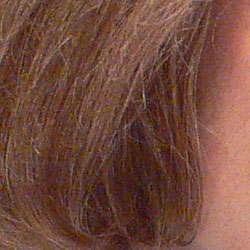
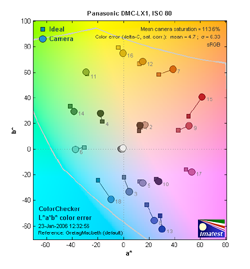


Follow Imaging Resource: